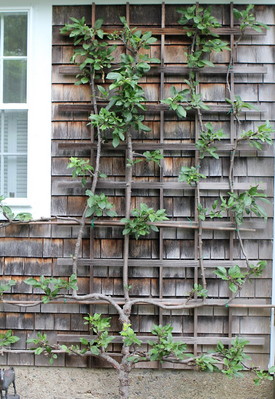 Keep the exposure of the wall in mind when selecting plants, like this espalier apple tree. |
Growing walls or “flower walls” can be as interesting and beautiful as any flat garden. If you want lots of garden but have too little space, consider growing plants up a wall, up a trellis, up an arbor or even up a fence or post. Vines can be used or trees and shrubs can be pruned to grow flat, in two dimensions, as in the famous kitchen garden at Versailles, where espalier fruit grows against the walls.
To grow up, plants require support. Short-lived plants such as flowers and vegetables can be tied to stakes or simple trellis made of wire. Over time, however, well-designed trellises made of permanent wood, metal or attractive plastic are more pleasing and longer-lasting. How sad it is to grow a magnificent old clematis for ten years and display it on an ugly chain-link fence.
Very elaborate structures are possible, such as pergolas with columns as in ancient Rome or arbors covered with climbing roses intertwined with morning glory or clematis vines. Other vines that grow up are rambler roses, wisteria and honeysuckle, all of which require yearly pruning. Remember with wisteria that, over time, the main vine will become almost as large as a tree trunk, so train it to the shape you want it to remain. Climbing hydrangea and clematis will tolerate shade.
Many trees and shrubs can be pruned flat into espalier forms. Most of the small fruit trees, particularly dwarf apples, withstand heavy pruning and can be used. Upright yews and juniper also work well. The secret is to start when the plants are young and train the way you want them to grow.
Espalier plants are traditionally shaped like a candelabra or other complex geometric designs. They need not be only geometric or classic though. An informal clipping can produce a windswept look or a fan shape.
Saving Energy
Growing walls and espalier plants are especially useful for energy saving. Plants growing against a south-facing wall will keep it cool. Evergreen plants will provide some protection from wind in winter. Overhead arbors and pergolas are the ancient Roman way to provide cool shade in summer. A vine shading a window air conditioner is highly recommended as it will significantly reduce the energy used for cooling for that unit.
Hit-or-miss planting will not be too successful. Gardening, like agriculture, is complex. Successful growing requires choosing plants that will thrive in each microenvironment. The exposure of the wall should be considered — whether it faces north, south, east, or west, whether it gets lots of wind and how much sun it receives.
North walls tend to be cool and require plants that can live without sunlight. One could use shade-tolerant trees such as amalanchier and redbud. These might be underplanted with a flower border of spring bulbs, shade-tolerant hosta, ferns, bleeding heart and lily of the valley, as well as annual impatiens for summer color.
East-facing walls would probably have enough sunlight to add azaleas, rhododendron, coral bells, daylilies, astilbe, flowering cherry or dogwood.
Sunny south and west walls get very hot and can cook plants. Your choices must be able to tolerate heat to do well on these exposures and they will require lots of water during hot summer days.
Windy walls also need extra water to compensate for evaporation from the leaves. Keeping this in mind, one would not plant rhododendrons on a south or west wall, but roses and fruit trees would do very well. So would vegetables and most flowers.
Generally, sun-lovng plants need at least four hours of sun a day. One can manipulate the light by the use of color. A light-colored wall will be cooler and will reflect more heat than a dark one. To increase the effective sun in a shady spot, hang aluminum foil behind the plants to reflect sunlight back onto the leaves. The more sun, the more these will flower, for sun is the real secret of profuse blooming.
Credit: www.mothersgarden.net




























